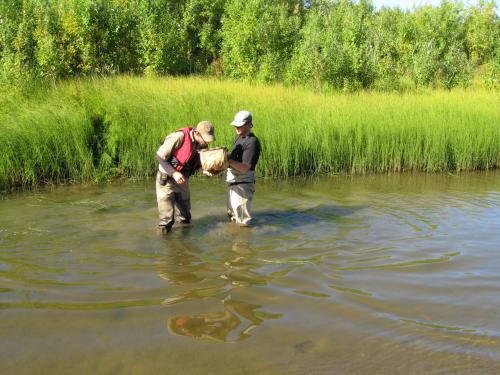The statement resonated in my head: “Several orders (of insects) that occur regularly in streams of temperate North America are absent (or in very low abundance) in interior Alaskan streams - Hemiptera, Odonata, Megaloptera, Coleoptera.” I saw the sentence in an abstract that I read before leaving for the Kobuk River in Northwest Alaska. At the time it made a lot of sense. The cold arctic winters were known to select for only the most tolerant of macroinvertebrates, and much of the literature suggested that the dipterans would dominate the Kobuk River invertebrate community due to their unique physiological adaptations.
Data collection from the mainstem of the Kobuk River was somewhat consistent with the literature (at least in terms of the orders of insects sampled and abundance), but a greater diversity of insects was apparent from the onset. We sampled additional habitats throughout the watershed and came to the partial conclusion that those areas with a slower residence time of water (i.e. backwaters, side channels, and tributaries) showed a greater diversity and abundance of aquatic insects in comparison to the mainstem river. Shallower photic zones, open canopies, less frequent bed mobilization, and a decrease in the residence time of water should encourage increased rates of primary productivity which may have a cascading effect on other trophic constituents.
On August 20th, we were finally able to sample our first Kobuk River oxbow. Wading along the margins of the oxbow, I swept my net through the emergent vegetation and was overwhelmed with what I found. At least three families of Hemiptera (including corixids and gerrids), two families of odonates, one annelid family, several Coleoptera larvae, a dytiscid adult coleopteran, and two reputedly rare families of Trichoptera (Leptoceridae) and Ephemeroptera (Amelitidae). With a few sweeps through the oxbow we documented most of the insect orders we were not supposed to see.

I am left to conclude that oxbow lakes likely play a very important role in the secondary production of aquatic macroinvertebrates within the Kobuk River watershed. During periods of low flow, resident consumers (including birds and mammals) likely benefit from enhanced productivity when compared with other Kobuk River habitats. However, episodic connectivity between the mainstem Kobuk River and adjacent oxbow lakes during periods of high flow likely constitute an important and major secondary production subsidy to an otherwise depauperate mainstem system.

